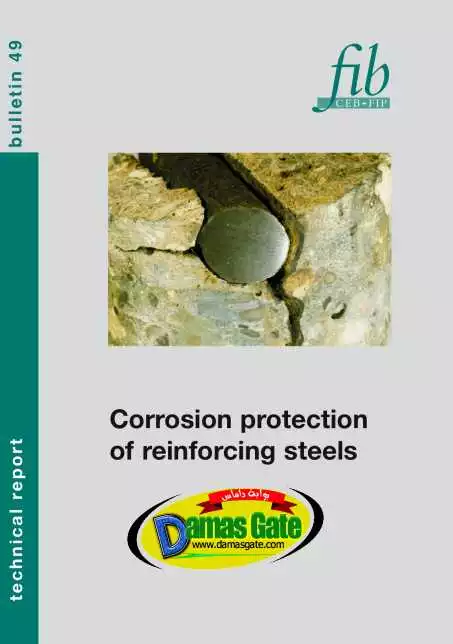FIB-49 Corrosion protection of reinforcing steels
1 Introduction
In reinforced concrete structures the concrete guarantees chemical and physical corrosion protection of the unalloyed reinforcement. Thus, the alkaline electrolyte in the pores of the concrete passivates the steel and prevents anodic dissolution of iron. Further the concrete – as a more or less dense (fine porous) material - keeps corrosion-promoting substances away from the reinforcement. That is, if a sufficient depth of concrete cover and a high concrete quality are provided. In general, steel, in concrete is adequately protected against corrosion.

Loss of durability in reinforced concrete apart from problems caused by poor design and construction only occurs if the passivating oxide layer is rendered unstable (if depassivation occurs) due to carbonation of the concrete reducing the alkalinity of the pore solution in the hardened cement paste around the steel or to the ingress of chlorides to the steel /concrete interface [1,2]. Alkalinity can be lost by the ingress of carbon dioxide from the atmosphere into the permeable concrete, to neutralise the alkaline hydroxides by forming carbonates, thus lowering the pH. If the penetration front, which may also include moisture and oxygen reaches the reinforcement, corrosion may occur. The probability of this event depends upon the degree of permeability and porosity of the concrete.
Excessive chloride levels may arise from a number of sources, such as marine environments
and the use of de-icing salts, particularly on roads, bridges and in car parks. Chloride ions together with water may penetrate into hardened concrete of structures. If the chloride content reaches a critical level at the surface of the reinforcement, the protective layer may be broken locally and pitting corrosion can take place. For non-carbonated concrete exposed to the atmosphere the critical chloride content is about 0,4 -1% by mass of cement.
Download
*
1 Introduction
In reinforced concrete structures the concrete guarantees chemical and physical corrosion protection of the unalloyed reinforcement. Thus, the alkaline electrolyte in the pores of the concrete passivates the steel and prevents anodic dissolution of iron. Further the concrete – as a more or less dense (fine porous) material - keeps corrosion-promoting substances away from the reinforcement. That is, if a sufficient depth of concrete cover and a high concrete quality are provided. In general, steel, in concrete is adequately protected against corrosion.

Loss of durability in reinforced concrete apart from problems caused by poor design and construction only occurs if the passivating oxide layer is rendered unstable (if depassivation occurs) due to carbonation of the concrete reducing the alkalinity of the pore solution in the hardened cement paste around the steel or to the ingress of chlorides to the steel /concrete interface [1,2]. Alkalinity can be lost by the ingress of carbon dioxide from the atmosphere into the permeable concrete, to neutralise the alkaline hydroxides by forming carbonates, thus lowering the pH. If the penetration front, which may also include moisture and oxygen reaches the reinforcement, corrosion may occur. The probability of this event depends upon the degree of permeability and porosity of the concrete.
Excessive chloride levels may arise from a number of sources, such as marine environments
and the use of de-icing salts, particularly on roads, bridges and in car parks. Chloride ions together with water may penetrate into hardened concrete of structures. If the chloride content reaches a critical level at the surface of the reinforcement, the protective layer may be broken locally and pitting corrosion can take place. For non-carbonated concrete exposed to the atmosphere the critical chloride content is about 0,4 -1% by mass of cement.
Download
*